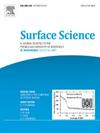First-principles study: Effect of biaxial strain on the optoelectronic properties of O-doped monolayer GaSe
IF 2.1
4区 化学
Q3 CHEMISTRY, PHYSICAL
引用次数: 0
Abstract
This paper focuses on the effect of biaxial tensile-compressive strain on the structural stability and photoelectric properties of O-doped monolayer GaSe based on the first calculations. This study demonstrates that the pure structure has good thermal stability at room temperature. The most stable doping is indicated by the O doped formation energy, which is the smallest (-2.57 eV) after doping with atoms B, C, N, O, and F. The O-doped system attains its most stable configuration after applying a strain of -4 %. The introduction of impurity energy levels following atomic doping leads to a considerable decline of the band gap. For the pure structure and O-doped system, the tensile strain leads to a steady decrease in the band gap; compressive strain first increases and then decreases the band gap. Contrasted with the pure structure, applying strains of -6 % and -8 % causes the O-doped system to switch from an indirect to a direct bandgap, increasing the material's photovoltaic conversion efficiency. The absorption peak of monolayer GaSe shifts to the blue with tensile strain. The O-doped system after applying a strain of -8 % performs optimally in terms of light absorption and reflection. The results provide a theoretical basis for applying monolayer GaSe in optoelectronics.

第一性原理研究:双轴应变对o掺杂单层GaSe光电性能的影响
本文在第一次计算的基础上,重点研究了双轴拉压应变对掺杂o的单层GaSe结构稳定性和光电性能的影响。研究表明,纯结构在室温下具有良好的热稳定性。在B、C、N、O和f原子掺杂后,O掺杂的形成能最小(-2.57 eV),在施加- 4%的应变后,O掺杂体系达到了最稳定的构型。原子掺杂后杂质能级的引入导致带隙的显著下降。对于纯结构和掺杂o的体系,拉伸应变导致带隙稳定减小;压缩应变先增大后减小带隙。与纯结构相比,施加- 6%和- 8%的应变使o掺杂体系从间接带隙切换到直接带隙,提高了材料的光伏转换效率。随着拉伸应变的增加,单层GaSe的吸收峰向蓝色方向移动。在施加- 8%的应变后,o掺杂系统在光吸收和反射方面表现最佳。研究结果为单层GaSe在光电子学中的应用提供了理论基础。
本文章由计算机程序翻译,如有差异,请以英文原文为准。
求助全文
约1分钟内获得全文
求助全文
来源期刊

Surface Science
化学-物理:凝聚态物理
CiteScore
3.30
自引率
5.30%
发文量
137
审稿时长
25 days
期刊介绍:
Surface Science is devoted to elucidating the fundamental aspects of chemistry and physics occurring at a wide range of surfaces and interfaces and to disseminating this knowledge fast. The journal welcomes a broad spectrum of topics, including but not limited to:
• model systems (e.g. in Ultra High Vacuum) under well-controlled reactive conditions
• nanoscale science and engineering, including manipulation of matter at the atomic/molecular scale and assembly phenomena
• reactivity of surfaces as related to various applied areas including heterogeneous catalysis, chemistry at electrified interfaces, and semiconductors functionalization
• phenomena at interfaces relevant to energy storage and conversion, and fuels production and utilization
• surface reactivity for environmental protection and pollution remediation
• interactions at surfaces of soft matter, including polymers and biomaterials.
Both experimental and theoretical work, including modeling, is within the scope of the journal. Work published in Surface Science reaches a wide readership, from chemistry and physics to biology and materials science and engineering, providing an excellent forum for cross-fertilization of ideas and broad dissemination of scientific discoveries.
 求助内容:
求助内容: 应助结果提醒方式:
应助结果提醒方式:


